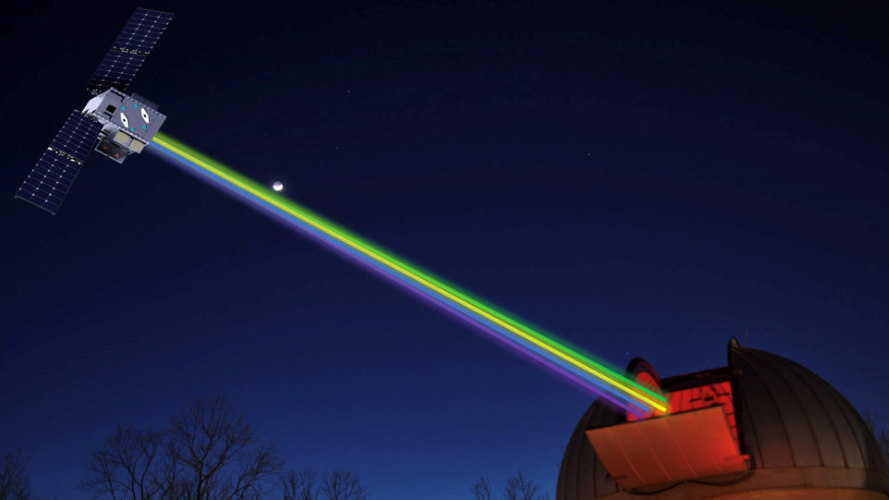To calibrate telescopes on Earth, NASA's launching an 'artificial star' to orbit
Set to reach Earth orbit in 2029, the small satellite will serve to fine-tune telescopes on our planet.

Come 2029, skywatchers can glimpse at least one "star" in the sky made by humans.
Earlier this week, NASA announced plans to place a small satellite in Earth orbit at a little over 22,000 miles (35,400 kilometers) above our planet's surface — far enough for the satellite to mimic a real star to telescopes on Earth. Scientists say the satellite, named Landolt, wouldn't be bright enough to be seen with the unaided eye, but if you happen to have a personal telescope at home, you may be able to spot a shoebox-sized object hovering above the United States in a stationary position.
The mission's primary goal is to help calibrate telescopes on Earth and create new, more accurate catalogs of the brightnesses of real stars.
Once in orbit, the satellite will beam eight onboard lasers at ground-based telescopes, which would observe the "artificial star" in the same frame as their science targets. After measuring how much of the lasers' light — which would have a predetermined brightness — gets absorbed by our planet's atmosphere, astronomers can compare it with about 60 real stars, thereby cataloging stellar brightness, as seen from Earth, more precisely than conventional methods can achieve.
"Lasers in space is a pretty cool selling point, as is getting to work on a mission," mission team member Jamie Tayar, an assistant professor of astronomy at the University of Florida, said in a statement. "But scientifically, what we're trying to do here is really fundamental."
Related: Bark! Meow! Cluck! NASA uses lasers to beam pictures of pet dogs, cats and chickens to the ISS
Better catalogs of stellar luminosities will boost the accuracy with which various properties of stars, such as their brightnesses, sizes and ages are measured. This accuracy, in turn, can allow scientists to fine-tune other measurements that rely on stellar brightnesses and distances as well. For instance, stellar dynamics like these help us measure the universe's age and how quickly it has expanded over time. Astronomers can also more precisely infer how much energy emanates from stars, which could aid the search for orbiting exoplanets with potentially life-friendly conditions.
Breaking space news, the latest updates on rocket launches, skywatching events and more!
"There are so many big questions in astronomy: How did we get here? Are there other planets like ours? Do aliens exist?" said Tayar. "But those are really hard questions, and so to answer them the measurements have to be really good, and they have to be right."
Normally, to measure the universe, astronomers rely on stars referred to as "standard candles," which can be likened to light bulbs of known wattage. Brightness and distance factors for these stars are well-recorded, and are thus used as tools to measure distances between other stars or galaxies and Earth. Those measurements, however, were made in the 1990s and "have become the principal source of error in measuring the luminosity for a majority of stars," according to a news release by the University of Montreal in Canada, which is involved with the mission.
"When we look at a star with a telescope, no one can tell you today the rate of photons or brightness coming from it with the desired level of accuracy," said Peter Plavchan of George Mason University, who is the principal investigator for the mission. "We will now know exactly how many photons-per-second come out of this source to 0.25 percent accuracy."
Data from the $19.5-million Landolt mission will reduce uncertainties in brightness measurements of stars from 10 percent to one percent, astronomers say. "That makes a difference when propagated into the properties of exoplanets and, believe it or not, some of the parameters used to determine the structure of the universe," Angelle Tanner of the Mississippi State University, who leads the mission's science and manages a sub-grant of $300,000, said in another statement.
The mission is named in honor of the late American astronomer Arlo Landolt, who is best known for his photometric standard star lists, which are widely used as calibration yardsticks when studying new objects in the sky. Mission control will be based out of the George Mason University's campus in Fairfax County, Virginia, with collaborations with scientists from 12 institutions. The payload itself will be built by the U.S. Department of Commerce's National Institute of Standards and Technology, which is headquartered in Maryland.

Sharmila Kuthunur is an independent space journalist based in Bengaluru, India. Her work has also appeared in Scientific American, Science, Astronomy and Live Science, among other publications. She holds a master's degree in journalism from Northeastern University in Boston.
